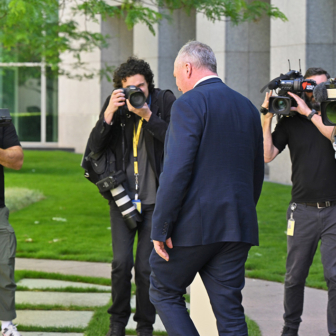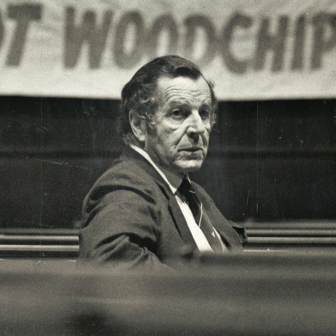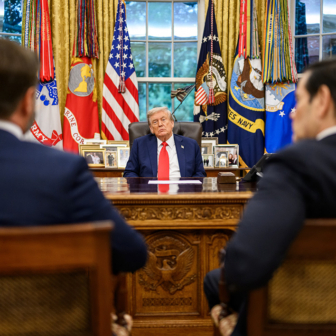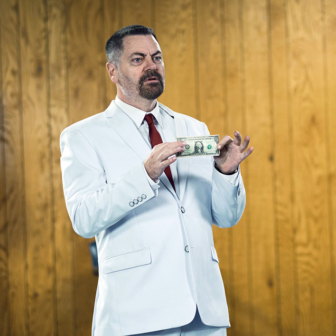It is salutary to turn on the television on the morning after the biggest landslide to the Labor Party since 1943 and the Liberal Party’s worst-ever election defeat. We must have had Sky on by the time we went to bed because that’s what came on. And there was Liberal Party backroom veteran from way back, Michael Kroger, complaining about debt, whining about Labor lies and scare campaigns, and joking about how pleased Alan Bond and Christopher Skase would be with the state of the country.
Much of the Australian electorate today would not know their Bond from their Skase. The times have changed; the Liberal Party has failed to change with them. At the time of writing, the two-party-preferred split in Labor’s favour is sitting at 55.4 per cent and 44.6 per cent. To put that in perspective: Labor in 1983 under a charismatic new leader, Bob Hawke, managed 53.2 per cent. Albanese has done slightly better than Chifley in 1946, and the landslide is in the same league as John Curtin’s wartime effort in 1943. Its seat tally for the House of Representatives could end up in the nineties. Seats that were marginal at the last election — Bennelong, John Howard’s former seat, for example — would now be classified as “safe” Labor if there is still such a thing as a safe seat.
No one should imagine that this was just a bad day, or a bad campaign, for the Liberals. The implications look greater for the defeated side than in the landslides of 1949 and 1996. Those elections saw the Coalition swept to power, but neither destroyed the viability of the defeated party, Labor.
This time, the Liberals have been virtually eradicated from urban Australia, the places where most of us live. It has no seats at all in Adelaide, or in Tasmania. It has lost seats in Melbourne, Sydney and Brisbane, and one in Far North Queensland, Leichhardt. Peter Dutton has no natural successor as leader, although Angus Taylor seems most likely. Teal independents, mostly in formerly blue-ribbon Liberal strongholds, have held their seats and look like they’ll get more. This is a once-in-a-century crisis for any political party, perhaps for any organisation.
The Liberals are in danger of becoming the Kodak of Australian politics. They are certainly in the deepest crisis since their formation in 1944. It is hackneyed to point out that this is not the party of Menzies, but that does not make the claim untrue.
Read the foundational documents of the party from the 1940s: yes, there is anti-socialism, but lying behind it was a profound and positive idealism, a generous, optimistic vision of a gently civilising state. For Menzies, the goal was “a true revival of liberal thought which will work for social justice and security, for national power and national progress, and for the full development of the individual citizen, though not through the dull and deadening process of Socialism.” It was a vision that valued freedom, service and community, and which depended on the purpose and patriotism of ordinary men and women. That included young people and women.
Liberals often genuflect to “The Forgotten People,” Robert Menzies’s famous radio broadcast of 1942. They would do much better to read what he actually said, because it was an eloquent celebration of the virtue and potential of ordinary Australians. And here is a young ex-RAAF fighter pilot, wounded several times, who would ride Menzies’s coat-tails into the senate in 1949. The speech was delivered at Mystic Park in rural Victoria in 1946:
We must remove from the minds of men the fear of poverty as the result of illness, or accident, or old age. We must turn our schools into institutions which will produce young men and women avid for further education and increased knowledge. We must raise the material standard of living so that all children can grow up with sufficient space and light and proper nourishment; so that women may be freed from domestic drudgery; and so that those scientific inventions which are conducive to a more gracious life may be brought within the means of all. We must raise the spiritual standard of living so that we may get a spirit of service to the community and so that we may live together without hate, even though we differ on the best road to reach our objectives. And we must do all this without losing that political freedom which has cost us so dearly, and without which these tasks cannot be accomplished.
John Gorton, the speaker, was elected in 1949 and would become Liberal prime minister in 1968. His vision was generous, compassionate and cosmopolitan: of an Australia and a wider world “in which meanness and poverty, tyranny and hate, have no existence.”
It is almost impossible to imagine a young, aspiring Liberal with their eye on a political career speaking in such terms today. He, or she, would be practised in attacking Labor, Greens and, perhaps most of all, teal independents. The new party to which Gorton attached himself was liberal, progressive and idealistic. The old party Peter Dutton led to defeat on Saturday was conservative, populist and cynical.
The standard issue facial expression is the sneer, the verbal reflex the sledge. And not just the sneering at and sledging of the political opponents you are actually fighting. Early in his campaign, Dutton was talking about how he could coerce those involved in woke “indoctrination” of students in schools. He insulted and threatened hard-working teachers and school communities in the interests of prosecuting US-inspired cultural wars. Later in the campaign, he disavowed any intention of interfering in the national curriculum.
What was this all about? My best guess is that the first was Dutton acting on his right-wing populist instincts. The backflip presumably came out of more mature calculation as an increasingly disastrous campaign went well off the rails. A more sensible strategy might have been, from the first, to celebrate the achievements of Australian schools and commit the Coalition to making them even better in the interests of the nation.
These sorts of failures occurred across a wide range of issues. Why attack public servants, pretending that there is a distinction to be made between those offering “frontline” services and involved in “national security” (who do necessary and valuable work), and the rest of them who are presumably (in the Liberal telling) parasites on the taxpayer? Did it occur to anyone at Liberal headquarters that a wider group of voters might read into this a “philosophy,” not about Canberra public servants alone but the Australian public sector as a whole?
Similarly, it was no defence that the Liberals’ foolish “work from home” policy was only to apply to federal public servants. Naturally, workers in the private sector, many of them women, saw a wider hostility to their job arrangements. The damage was done by the time the backflip occurred, and at least one shadow minister seemed to think the policy worth defending even after it was formally abandoned.
And then there was the absurdity of the Coalition’s nuclear policy, which had Dutton explaining that the federal government could override state governments — including Liberal ones — to build his power stations. This, from a party that used to be committed to meaningful federalism and states’ rights.
The Coalition will presumably junk a lot of this policy but God only knows what it will put in its place. It has abandoned the political centre to Albanese and Labor and seems unlikely to be in a position to win it back any time soon. Some of its most promising younger MPs are either defeated or in danger of losing their seats. Half the MHRs will likely be from Queensland. All but a few survivors will be representing rural and regional seats.
The quality of some of the party’s candidates was appalling, with several little bombs going off throughout the campaign to distract voters, possibly worrying them that the party was harbouring its own miniature version of a Trump-like freak show. The prominence of the Exclusive Brethren handing out at polling booths for the Liberals will not have helped dispel such an impression. When the Liberals are able to attract a local battler like Labor’s Ali France, who has defeated Dutton in Dickson on her third try, they will know they’ve turned a corner.
The Liberals’ post-election review will be worth reading and, one way or another, we will eventually be offered a better account of why the campaign was so amateurish. But the Liberals really need to look at their trajectory over the whole post-Howard era. And they should revisit why they did so little over the last three years to try bringing the alienated back into the fold, especially younger voters and women. Their “strategy” of winning over vast numbers of Labor voters in the outer suburbs to become the real party of the workers has been exposed for the fantasy it was.
The Coalition also suffers increasingly from its friends in the Murdoch media, who continue to pursue personal vendettas against enemies including the teals — invariably accomplished professional women in whom other women see something of themselves and their aspirations — and culture wars that most voters regard as the obsession of fanatics of a kind they would avoid at weddings, parties and bar mitzvahs. The Liberals would do well to treat voters as sensible adults capable of exercising reason and judgement rather than as bundles of appetites, prejudices and fears. They could even extend their interest in countering racism beyond an antisemitism to be pinned on their opponents for political gain, and their engagement with anti-discrimination beyond the supposed disabilities suffered by Christians.
As a party claiming special skill in economic management, they might consider refraining from wasting billions of dollars on cheap petrol and expensive nuclear power. They might lose their addiction to fossil fuels, and to the favours of deeply unpopular billionaires such as Gina Rinehart. They might look at how it was that under Menzies, rates of home ownership increased from 50 per cent to more than 70 per cent. (Hint: it wasn’t by making interest payments tax deductible for first-time home-builders for five years.) They might drop the “immigrants are stopping you getting a home” stuff.
Above all, the Liberals would do well to lose the sneer. They should not sneer at teachers and public servants. They should not sneer at government schools and universities. They should not give the impression that they believe young people are irredeemably “woke” and that women remain second-class workers and citizens. They should not sneer at the unemployed: they might rather consider how they might outflank Labor on support for JobSeeker. They should not sneer about the deficits of First Nations communities: they should celebrate their achievements and support their aspirations.
If they did all of this, it would still be less than the renovation achieved by the centre right in the 1940s under the guiding hand of Menzies. The combined United Australia Party and Country Party share of the two-party preferred vote was probably below 42 per cent at the 1943 election, and it won just twenty-three seats in a house of seventy-four. The UAP was in such a mess that its leader was the octogenarian Billy Hughes and the opposition leader the Country Party’s Artie Fadden.
In his gracious concession speech, Peter Dutton said the Liberals would rebuild because “we know our values, we know our beliefs and we’ll always stick to them.” But he refrained from saying what those values and beliefs were. He probably just wanted to go home. Fair enough, too. But making good that omission will be the most fundamental challenge for those he leaves behind as the Liberal Party contemplates its future. •




